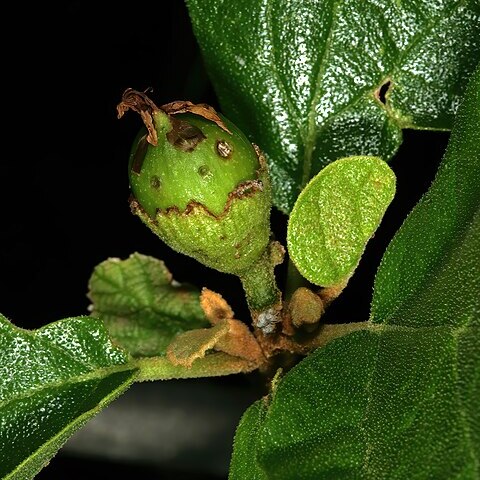Spreading shrub to small bushy tree 0.3-4.5(-6) m tall, sometimes even said to be ± creeping; young shoots ridged, often pubescent, lenticellate, the innovations pale ferruginous pubescent; bark dark, grey or almost black, thick, corky, deeply longitudinally fissured; slash soft grey-brown outer area and soft yellow-brown inner. Leaves nearly always opposite, rarely alternate on some shoots; blades oblong or narrowly oblong to oblong-elliptic, 0.9-7.5(-10) cm long, 0.7-4(-5) cm wide, rounded to slightly indented at the apex and ± mucronulate, rounded to cuneate at the base, entire or very slightly crenate towards the apex, slightly rough above with short white hairs and with longer white hairs beneath, often quite dense or with longer hairs on both surfaces; venation ± reticulate beneath; mostly subsessile or petiole up to 7 mm long. Flowers in ± sessile cymes or peduncle 0.8-1.5 cm long; pedicels 0-1 mm long becoming 4-5 mm in fruit. Calyx densely adpressed pubescent or velvety, becoming glabrescent in fruiting stage; tube 3.5-4(-6.5) mm long, shortly lobed. Corolla white. Male: corolla-lobes up to 6 mm long; stamens exserted 3-5 mm; style ± obsolete or if present then stigma not reaching the anthers. Female: corolla-tube 3.5-5 mm long; lobes 2-4.5 mm long, 1-1.5 mm wide; filaments exserted 1.5 mm; style 3 mm long with branches 0.5-1.3 mm long and stigmas 2-2.5 mm long, well exserted. Fruit golden yellow or bright orange, ovoid with sharp beak-like style-base, 1-1.7 cm long, 0.7-1 cm wide, mucilaginous and edible; endocarps yellowish, ellipsoid, 6 mm long, 4 mm wide; fruiting calyx cupular, 9 mm diameter.

